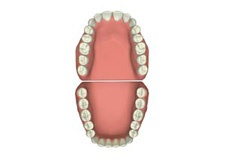Gingivitis Cure

Finding the Right Gingivitis Cure
Those seeking a gingivitis cure will need to allow their dentist to decide on the proper treatment. The treatment that is right for each patient will vary based on several factors, including how far the gum disease has progressed. Some of these cures will be discussed later in the article, but first let’s take a look at prevention.
Gingivitis is a periodontal disease that causes the gums to swell and bleed. Failing to properly treat and cure gingivitis can lead to far more serious dental issues and result in tooth loss and other problems.
The best news about gingivitis is that it is almost always 100% preventable. All it takes is a good routine of oral hygiene. Because gingivitis is caused by a build up of plaque and tartar, all you have to do to prevent the disease is make sure that no such build up ever occurs on your teeth.
Brushing at least two times a day is the first step. Many dental professionals would say that you should brush at least three times as well as after eating anything. Two times a day, however, is the bare minimum.
The next step is flossing. No matter what the manufacturers of your toothbrush promised, there is no toothbrush that can take the place of flossing. You must learn to floss properly and then floss twice a day. This will remove the tartar and plaque from between the teeth where the toothbrush cannot reach.
Failing to floss properly is the leading cause of gingivitis in those who brush regularly and otherwise have good oral hygiene. Some people actually view flossing as optional. It is not. It is an important part of maintaining the health of your mouth.
Extra steps that you can take to prevent gingivitis include rinsing with salt water or with an antiseptic mouthwash or rinse.
Once gingivitis is diagnosed, it is important to start a gingivitis cure as soon as possible. The sooner you can cure the disease, the less likely it is that further problems will develop.
Here are a few additional symptoms of gingivitis.
Persistent bad breath
Receding gum line
Pain or bleeding when brushing
Loose teeth
Your dentist may recommend a gingivitis cure that does not involve surgery. These may include a very deep cleaning of the teeth and gums. Scaling and root planing is another non-surgical treatment. This is a VERY deep cleaning that is done while the patient is under a local anesthetic. This treatment is used when there is a build up of plaque or tartar beneath the gum line.
If the above treatments do not help, your dentist may then recommend a gingivitis cure that does involve surgery. These may include bone grafts, soft tissue grafts or tissue regeneration. The last option is only performed in severe cases where the supporting bones have started to deteriorate.
The further along the disease progresses, the more radical the gingivitis cure is going to be. The best thing that you can do is start today on a dental plan that will both prevent and detect gingivitis.
Should you start to show signs of the disease, you should not put off treatment. The sooner you start a gingivitis cure, the less damage the disease will be able to do.